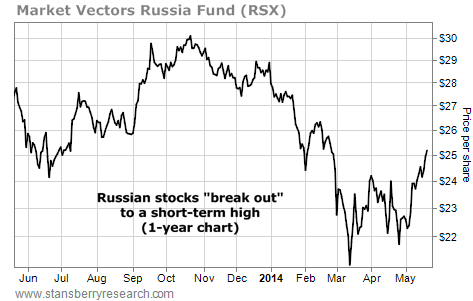| Home | About Us | Resources | Archive | Free Reports | Market Window |
What My Stock-Market Warning Sign Is Saying TodayBy
Wednesday, May 21, 2014
Readers of Retirement Millionaire have made a fortune in this bull market...
Over the past five years, our average gain is 50%.
We've made such great gains by ignoring "doom and gloom" pessimists who would have you believe we're about to enter another depression. Instead, we've focused on facts, owned U.S. stocks, and we've made huge gains.
But no bull market lasts forever. And when a bull market is ready to end, there are some indicators that often flash warnings sings. We'll take a look at one of these indicators today...
While most investors imagine themselves as calculating and rational... the truth is, most are driven by misinformation and emotion.
As a result, when general optimism is at an extreme... when everyone is buying... that's usually the best time to sell. A big drop is likely around the corner. (The opposite is also true for times of extreme pessimism.)
That's the essence of what we call "being contrarian."
What does sentiment about the market tell us right now?
The American Association of Individual Investors ("AAII") – a nonprofit group focused on educating people on investing issues – publishes a weekly Sentiment Survey.
This is a reading of what percentage of individual investors consider themselves bullish, bearish, or neutral.
As I said, sentiment is often a contrarian indicator. When everyone is convinced that the market will continue rising and the bullish indicator hits an extreme high... that's when people get burned.
But right now, we're not at an extreme... Around 28% of individual investors think the market is headed higher.
That's high, but not enough to signal an imminent turnaround.
 For example, before the dot-com collapse, 60% of investors were bullish. Before the 2008 bust, more than 50% of investors were bullish. Those are levels that signal a big turn. Similarly, in 2002, when the bullish reading was at its lowest in almost 13 years, the market roared higher over the next five years.
There was also the high reading earlier this year. In January, about 55% of investors reported feeling bullish... just before the market cooled a bit.
Right now, you can find plenty of financial commentators claiming that the market is due for a turnaround. But it's not truly overheated. We won't likely reach a peak until the most ardent perma-bears throw up their hands and start investing.
So with the market likely to keep plowing higher, I'm urging my readers to continue buying quality U.S. stocks... including two that I've mentioned here recently, Chevron and Microsoft.
Here's to our health, wealth, and a great retirement,
Dr. David Eifrig Jr.
Further Reading:
Right now, Doc says some people may be tempted to buy volatile tech stocks like Twitter. "After all, some of them could be the 'next big thing,'" he writes. "That may be true... but you can earn even better returns by sticking to the old, 'boring' cash producers." Get all the details here.
Market NotesRUSSIA BREAKS OUT TO A SHORT-TERM HIGH India isn't the only investment destination where things are looking up. Russia is moving higher as well.
In yesterday's edition, we showed that Indian stocks have responded to a major election result. Indian stocks have struggled over the past few years. But they recently "broke out" to an important new high.
Another market enjoying some positive price action is Russia. On May 12, we noted that Russian stocks are some of the world's most despised securities. Investors had dumped Russian stocks in response to its military dealings.
One way to track Russian stocks is with the Market Vectors Russia Fund (RSX). It's a diversified basket of Russian stocks. Recently, RSX fell from $29 per share to around $21 per share. It spent the next few months trading in a sideways pattern in the $22-$23 area.
As you can see from the chart below, RSX isn't just "not falling" anymore... it's rising. In just the past week, shares broke out to a new multi-month high. An out-of-favor market rising in the face of bad news? It's a contrarian trading setup that usually leads to gains.
 |
Recent Articles
|



